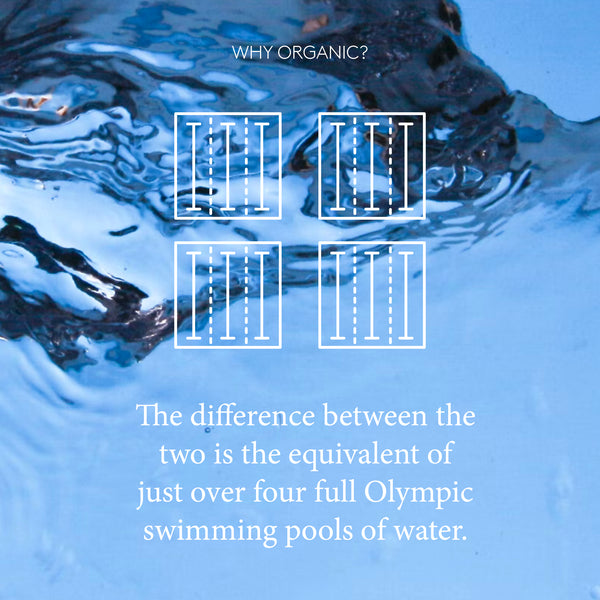
Emissions Not Omissions
At a glance
-
Our Australian retail operations emitted 3.09 tonnes of CO2eq over the past year – about the same as the average emissions produced by a small car over the same period.
- Our supply chain emissions, from the farm in Türkiye to our warehouse in Melbourne was 43.87 tonnes of CO2eq for Collection 01.
- We offset these emissions by purchasing 50 tonnes of carbon offsets from Greenfleet – approximately the carbon footprint of one person over 900 days.
- To produce Collection 01 - Green Story estimated that the total freshwater requirement for our organic cotton products was 1.01 million litres of water from farm to warehouse. For conventional cotton that is irrigated with freshwater this number would be 12.2 million litres of water. By choosing organic we reduce our freshwater consumption by 90%.
Organisations in Australia can be certified as carbon neutral. To do this a business calculates its Green House Gas emissions (“GHGs”) in terms of carbon dioxide equivalents (CO2eq). This is measured in three scopes.
Scope 1 emissions are those associated with running business operations in Australia. For example, electricity at an office, machinery operated at a warehouse and vehicles used by a company.
For Loop Home, this was 3.09 tonnes of CO2eq over the past year which we’ve purchased offsets through our partner, Greenfleet, to be carbon neutral.
Scope 2 emissions are GHGs released to the atmosphere from the indirect consumption of an energy commodity at the actual production facility. The carbon intensity of electricity production (Primary Energy Demand or PED) of our manufacturing facility in Türkiye is accounted for in the GHG figures of our carbon footprint.
A company’s Scope 3 carbon emissions includes everything beyond its direct operations and electricity use, including supply chain operations and end-product usage by customers. The research group MSCI estimates that for the oil and gas industry the Scope 3 emissions are more than six times the level of its Scope 1 and 2 emissions.
Scope 3 emissions don’t need to be reported, at least by law, under the Australian National Greenhouse & Energy Reporting Scheme. Unfortunately the real carbon footprint stays hidden under the covers.
We wanted to understand the ecological cost of what we’re selling so we commissioned a lifecycle assessment (LCA) of our entire supply chain in partnership with the leading environmental platform, Green Story. Their results are shown below.
The Stats – Collection 01
Carbon Footprint
Loop Home has two supply chains – one for our bed linen and another for our bath linen. Green Story calculated our carbon footprint per kilogram of finished textiles, from the farms we source our organic cotton from in Türkiye to our warehouse in Melbourne.
The average emissions for each kilogram of finished product are estimated at 11.6kg of CO2eq for our bedding and 7.54kg of CO2eq for our towels. These differences are driven by different production techniques – the footprint from farming the organic cotton is the same in both instances.
Collection 01 across the range had a finished total weight of 4.345 tonnes across these product categories for 43.87 tonnes of CO2eq, measured from all stages from farm to our Australian warehouse.
If we had used conventional cotton (non-organically farmed) the total emissions would be 52.23 tonnes of CO2eq, or 19% higher.
Our Scope 1 emissions are minimal compared to Scope 3. 93% of the carbon footprint of Loop Home sits outside of Australia.
You can see the breakdown below for towels:

Water Usage
Organic cotton must be predominantly rainfed so the reduction in water usage is significant when compared to conventional cotton that requires irrigation.
For Collection 01, Green Story estimated that the total freshwater requirement for the collection to be 1.01 million litres of water. For conventional cotton that is irrigated with freshwater this number would be 12.2 million litres of water.

As a new business, we haven’t yet calculated the footprint from when our products are sold, in use and lastly at the end of their useful life, but research from McKinsey & Co in partnership with Global Fashion Agenda shows that these areas typically account for ~23% of the GHG emissions of the apparel and footwear industry.
At Loop Home, we advise customers on how to care for products while minimising the environmental impact of doing so, such as using an organic detergent. Line drying items instead of using the dryer. Simple stuff - with no loss of product functionality or quality.
When you’re ready to say goodbye to our products we’ll be there to say hello – our upcycling program, Re-Loop, will provide you with a store credit equal to 8% of your original purchase price.
The fashion industry produced around 2.1 billion tonnes of GHG emissions in 2018, equal to 4% of the global total emissions – McKinsey & Co // Global Fashion Agenda
Transparency is key for people to understand the problem and be informed to influence their purchasing behaviour and ask the question of their favourite brands.
Questions? You can reach us any time at hello@loophome.com.au.
